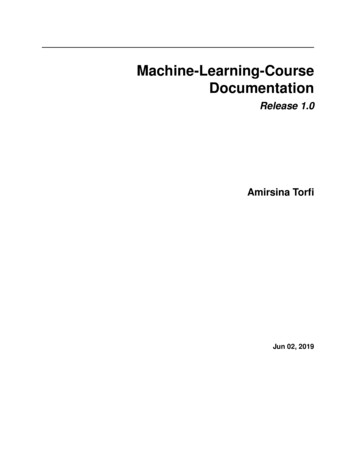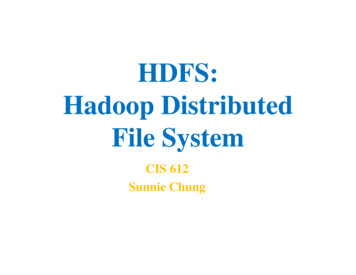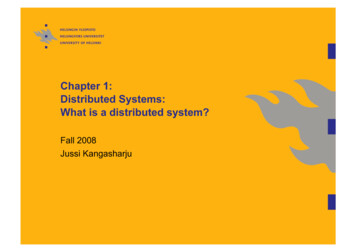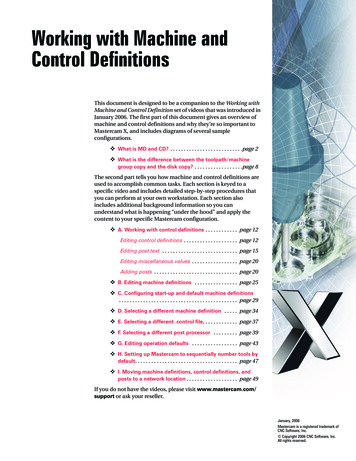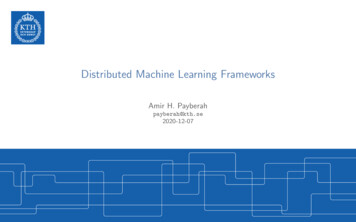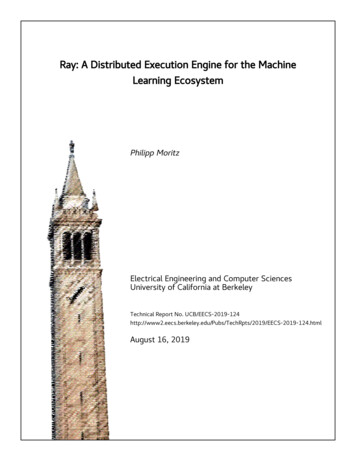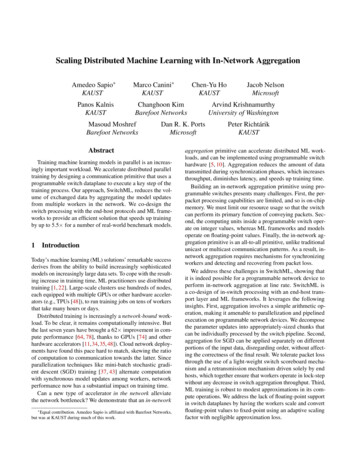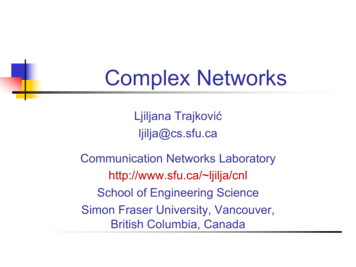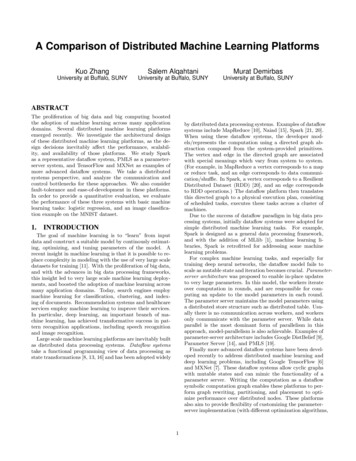
Transcription
A Comparison of Distributed Machine Learning PlatformsKuo ZhangSalem AlqahtaniMurat DemirbasUniversity at Buffalo, SUNYUniversity at Buffalo, SUNYUniversity at Buffalo, SUNYABSTRACTThe proliferation of big data and big computing boostedthe adoption of machine learning across many applicationdomains. Several distributed machine learning platformsemerged recently. We investigate the architectural designof these distributed machine learning platforms, as the design decisions inevitably affect the performance, scalability, and availability of those platforms. We study Sparkas a representative dataflow system, PMLS as a parameterserver system, and TensorFlow and MXNet as examples ofmore advanced dataflow systems. We take a distributedsystems perspective, and analyze the communication andcontrol bottlenecks for these approaches. We also considerfault-tolerance and ease-of-development in these platforms.In order to provide a quantitative evaluation, we evaluatethe performance of these three systems with basic machinelearning tasks: logistic regression, and an image classification example on the MNIST dataset.1.by distributed data processing systems. Examples of dataflowsystems include MapReduce [10], Naiad [15], Spark [21, 20].When using these dataflow systems, the developer models/represents the computation using a directed graph abstraction composed from the system-provided primitives.The vertex and edge in the directed graph are associatedwith special meanings which vary from system to system.(For example, in MapReduce a vertex corresponds to a mapor reduce task, and an edge corresponds to data communication/shuffle. In Spark, a vertex corresponds to a ResilientDistributed Dataset (RDD) [20], and an edge correspondsto RDD operations.) The dataflow platform then translatesthis directed graph to a physical execution plan, consistingof scheduled tasks, executes these tasks across a cluster ofmachines.Due to the success of dataflow paradigm in big data processing systems, initially dataflow systems were adopted forsimple distributed machine learning tasks. For example,Spark is designed as a general data processing framework,and with the addition of MLlib [1], machine learning libraries, Spark is retrofitted for addressing some machinelearning problems.For complex machine learning tasks, and especially fortraining deep neural networks, the dataflow model fails toscale as mutable state and iteration becomes crucial. Parameterserver architecture was proposed to enable in-place updatesto very large parameters. In this model, the workers iterateover computation in rounds, and are responsible for computing an update to the model parameters in each round.The parameter server maintains the model parameters usinga distributed store structure such as distributed table. Usually there is no communication across workers, and workersonly communicate with the parameter server. While dataparallel is the most dominant form of parallelism in thisapproach, model-parallelism is also achievable. Examples ofparameter-server architecture includes Google DistBelief [9],Parameter Server [14], and PMLS [19].Finally more advanced dataflow systems have been developed recently to address distributed machine learning anddeep learning problems, including Google TensorFlow [6]and MXNet [7]. These dataflow systems allow cyclic graphswith mutable states and can mimic the functionality of aparameter server. Writing the computation as a dataflowsymbolic computation graph enables these platforms to perform graph rewriting, partitioning, and placement to optimize performance over distributed nodes. These platformsalso aim to provide flexibility of customizing the parameterserver implementation (with different optimization algorithms,INTRODUCTIONThe goal of machine learning is to “learn” from inputdata and construct a suitable model by continously estimating, optimizing, and tuning parameters of the model. Arecent insight in machine learning is that it is possible to replace complexity in modeling with the use of very large scaledatasets for training [11]. With the proliferation of big data,and with the advances in big data processing frameworks,this insight led to very large scale machine learning deployments, and boosted the adoption of machine learning acrossmany application domains. Today, search engines employmachine learning for classification, clustering, and indexing of documents. Recommendation systems and healthcareservices employ machine learning to improve their services.In particular, deep learning, an important branch of machine learning, has achieved transformative success in pattern recognition applications, including speech recognitionand image recognition.Large scale machine learning platforms are inevitably builtas distributed data processing systems. Dataflow systemstake a functional programming view of data processing asstate transformations [8, 13, 16] and has been adopted widely1
consistency schemes, and parallelization strategies) at theapplication layer.at the nodes level and also enable optimizations by graphrewriting/partitioning when staging the computation on theunderlying distributed nodes. They provide, to some extent, flexibility of customizing the parameter-server implementation (with different optimization algorithms, consistency schemes, and parallelization strategies) at the application layer. While support for data-parallel training withparameter-server abstraction is provided, it is still very cumbersome to program model-parallel training using these platforms.Contributions of the paper. We investigate the architectural design of these distributed machine learning platforms, as the design decisions inevitably affect the performance, scalability, and availability of those platforms. Morespecifically, we compare and contrast the strengths and drawbacks of the dataflow and parameter-server approaches forbuilding distributed machine learning frameworks. We takea distributed systems perspective, and analyze the communication and control bottlenecks for these approaches.We also consider fault-tolerance and ease-of-development ofthese approaches.In order to provide a quantitative evaluation, we perform experiments with representative systems: Spark fordataflow, PMLS for parameter-server, and TensorFlow andMXNet as examples of more advanced hybrid dataflow systems. We evaluate the performance of these systems withthe same basic machine learning tasks: logistic regression,image classification using feed-forward neural network onthe MNIST dataset [2]. We also employ Ganglia systemmonitoring tool [3] to inspect the network, CPU, and memory utilization during training in order to reveal potentialsystem bottlenecks.Our experiments show that while Spark performs goodfor simple logistic regression, its performance dips for moreinvolved machine learning tasks. Spark does not have aparameter-server abstraction and this limits Spark’s scalability, especially when facing a machine learning task containing a large volume of model parameters. Keeping themodel as an RDD drags the performance of Spark significantly, so in our experiments we maintained and updatedthe model parameters at the driver. Even with this configuration, Spark’s performance falls below the other platformsfor image classification task with single and two hidden layers. We also found that the computation speed varies significantly with different numbers of RDD partitions.Our experiments show that the parameter-server modelprovides fast iteration and very good performance for training machine learning and deep learning tasks. Since PMLSimplements the parameter-server at a low-level using a highperformance programming language C , it achieves thebest performance in terms of speed in our experiments. WhilePMLS has very little overhead, on the negative side, thismeans that the users of PMLS need to know how to handlecomputation using relatively low-level APIs.The advanced dataflow systems developed for machinelearning, TensorFlow and MXNet, failed to perform wellin terms of speed. This is due to the overhead caused bythe high levels abstractions used in these platforms. On theother hand, these abstractions enable these systems to workon multiple platforms and leverage not only CPU but alsoGPU and other computational devices. While these systemshave been shown to scale to hundreds of machines, our experiments were performed with up to 6 workers, so they donot evaluate these platforms at large-scale. In our experiments, we found that asynchronous training of the workerswith respect to the parameter-server achieved higher speedsthan synchronous training.On the usability front, the advanced dataflow systemsprovide several benefits. By adopting symbolic executiongraphs, they abstract away from the distributed executionOutline of the rest of the paper. We provide a briefarchitectural overviews of Spark, PMLS, TensorFlow, andMXNet in Sections 2, 3, 4, and 5 respectively. In Section 6,we evaluate the performance of these platforms, and in Section 7 we present our concluding remarks and identify directions for future work.2.SPARK DATAFLOW SYSTEMIn order to achieve better performance than its forerunnerMapReduce, Spark enables in-memory caching of frequentlyused data and avoids the overhead of writing a lot of intermediate data to disk. For this Spark leverages on ResilientDistributed Datasets (RDD), read-only, partitioned collection of records distributed across a set of machines.In Spark, a computation is modeled as a directed acyclicgraph (DAG), where each vertex denotes an RDD and eachedge denotes an operation on RDD. On a DAG, an edge Efrom vertex A to vertex B implies that RDD B is a result ofperforming operation E on RDD A. There are two kinds ofoperations: transformations and actions. A transformation(e.g., map, filter, join) performs an operation on a RDDand produces a new RDD. An action (e.g., collect, count)triggers a job in Spark. A typical Spark job performs acouple of transformations on a sequence of RDDs and thenapplies an action to the latest RDD in the lineage of thewhole computation. A Spark application runs multiple jobsin sequence or in parallel.Figure 1: Spark ArchitectureFigure 1 shows the architecture of a Spark cluster, whichcomprises of a master and multiple worker. A master isresponsible for negotiating resource requests made by theSpark driver program corresponding to the submitted Sparkapplication. Worker processes hold Spark executors (each of2
accessible. If some stages that are required are no longeravailable, the missing partitions will be re-computed in parallel. Spark is unable to tolerate a scheduler failure of thedriver, but this can be addressed by replicating the metadata of the scheduler.The task scheduler monitors the state of running tasks andretries failed tasks. Sometimes, a slow straggler task maydrag the progress of a Spark job. As the size of cluster andthe number of tasks increase, the impact of stragglers become more significant. The task scheduler uses speculativerelaunch of straggling tasks in order to reduce the impact ofstragglers.Machine learning on Spark. Spark is not designedspecifically for machine learning, however, it has been retrofittedwith a machine learning library called MLlib that containscommon machine learning algorithms, utilities, and linearalgebra operations. In the basic machine learning setup,Spark stores the model parameters in the driver, and theworkers communicate with the driver to update the parameters after each iteration. However, for large scale machinelearning deployments, the model parameters may not fit intothe driver node and they would need to be maintained asan RDD. This introduces a lot of overhead because a newRDD will need to be created in each iteration to hold theupdated model parameters. Since updating the model usually involves shuffling data across machines, this limits thescalability of Spark.Figure 2: RDD Stageswhich is a JVM instance) that are responsible for executingSpark tasks. The Spark driver contains two scheduler components: the DAG scheduler and the task scheduler. TheDAG scheduler is responsible for stage-oriented scheduling,and the task scheduler is responsible for submitting tasksproduced by the DAG scheduler to the Spark executors.Unlike the MapReduce framework that consists of onlytwo computational stages, map and reduce, a Spark jobmay consist of a DAG of multiple stages. The stages arerun in topological order. A stage contains a set of independent tasks which perform computation on partitions ofRDDs. These tasks can be executed either in parallel or aspipelined. Spark defines two types of dependency relationthat can capture data dependency among a set of RDDs:narrow dependency and shuffle dependency (also called widedependency). Narrow dependency means each partition ofthe parent RDD is used by at most one partition of the childRDD. Examples include map, filter, and union transformations. Wide dependency means multiple child partitions ofRDD may depend on a single parent RDD partition. Examples include groupby and join transformations. It is thewide/shuffle dependency that defines the boundary of twoconnected stages. Data exchange across executors only happens between two adjacent stages and the result of shuffleddata from the previous stage constitutes the input of thenext stage.Figure 2 is a diagram of how Spark computes job stages.Spark employs a mechanism called “lazy evaluation” whichmeans a transformation is not performed immediately. Itwill wait until the whole computation DAG is built andeventually the execution including that transformation willbe triggered by an action in the same DAG. In this scenario,to run an action on RDD G, the Spark system builds stagesat wide dependencies and pipelines narrow transformationinside each stage. In other words, narrow dependencies aregood for efficient execution, whereas wide dependencies introduce bottlenecks since they disrupt pipelining and requirecommunication intensive shuffle operations.Fault tolerance. Spark uses the DAG to track the lineage of operations on RDDs. For shuffle dependency, theintermediate records from one stage are materialized on themachines holding parent partitions. This intermediate datais used for simplifying failure recovery. If a task fails, thetask will be retried as long as its stage’s parents are still3.PMLS PARAMETER-SERVER SYSTEMPMLS [19] takes a clean-slate approach and starts by identifying the objectives and features of machine learning systems. Most machine learning algorithms work in iterations.In each iteration the system performs computation on thedataset and the current model state and outputs an intermediate result, and secondly updates the model state basedon the result. Thus in PMLS, a worker process/thread isresponsible for requesting up to date model parameters andcarrying out computation over a partition of data, and aparameter-server thread is responsible for storing and updating model parameters and making response to the request from workers. 1Figure 3 shows the architecture of PMLS. The parameter server is implemented as distributed tables. All modelparameters are stored via these tables. A PMLS application can register more than one table. These tables aremaintained by server threads. Each table consists of multiple rows. Each cell in a row is identified by a column IDand typically stores one parameter. The rows of the tablescan be stored across multiple servers on different machines.Workers are responsible for performing computation definedby a user on partitioned dataset in each iteration and needto request up to date parameters for its computation. Eachworker may contain multiple working threads. There is nocommunication across workers. Instead, workers only communicate with servers. Note that “worker” and “server” arenot necessarily separated physically. In fact server threadsco-locate with the worker processes/threads in PMLS.1Originally, PMLS was named Petuum. PMLS consists ofBösen sub-system and Shards sub-system. In this paper wefocus on the Bösen sub-system which provides data-paralleltraining.3
ter updates to servers. While PMLS has very little overhead,on the negative side, the users of PMLS need to know howto handle computation using relatively low-level APIs.4.TENSORFLOWLeveraging their experience with DistBelief [9], a first generation distributed parameter-server system, Google opensourced TensorFlow [6] in November 2015. Similar to otherdataflow systems, in TensorFlow the computation is abstracted and represented by a directed graph. But unliketraditional dataflow systems, TensorFlow allows nodes torepresent computations that own or update mutable state.It provides stateful operations Variable, which owns mutable buffer, and can be used to store model parameters thatneed to be updated at each iteration. Nodes in the graphrepresent operations, and some operations are control flowoperations. Values that flow along the directed edges in theTensorFlow graph are Tensors, arbitrary dimensionality matrices. An operation can take in one or more tensors and produce a result tensor. In addition, special edges called control dependencies can be added into TensorFlow’s dataflowgraph with no data flowing along such edges. In summary,TensorFlow is a dataflow system that offers mutable stateand allows cyclic computation graph, and as such enablestraining a machine learning algorithm with parameter-servermodel.The Tensorflow runtime consists of three main components: client, master, worker. A client is responsible forholding a session where a user can define computationalgraph to run. When a client requests the evaluation of aTensorflow graph via a session object, the request is sentto master service. The master then schedules the job overone or more workers and coordinates the execution of thecomputational graph. Each worker handles requests fromthe master and schedules the execution of the kernels2 in thecomputational graph. The dataflow executor in a workerdispatches the kernels to local devices and runs the kernelsin parallel when possible.If multiple devices are involved in computation, a procedure called node placement is executed in a Tensorflowruntime. Tensorflow uses a cost model to estimate the costof executing an operation on all available devices (such asCPUs and GPUs) and assigns an operation to a suitabledevice to execute, subject to implicit or explicit device constraints in the graph. TensorFlow supports multiple communication protocols, including gRPC over TCP, and RDMAover Converged Ethernet.TensorFlow supports sub-graph execution. A single roundof executing a graph/sub-graph is called a step. A trainingapplication contains two type of jobs: parameter server (ps)job and worker job. Like data parallelism in PMLS, TensorFlow’s data parallelism training involves multiple tasksin a worker job training the same model on different minibatches of data, updating shared parameters hosted in a oneor more tasks in a ps job.Figure 4 illustrates a typical replicated training structurecalled between-graph replication, where there is a separateclient for each worker task, typically in the same processas the worker task. Each client builds a similar graph containing the parameters (pinned to ps) and a single copy ofFigure 3: PMLS (Bösen) ArchitecturePMLS exploits the error-tolerant property of many machine learning algorithms to make a trade-off between efficiency and consistency. Most machine learning algorithmscan tolerate bounded error in their iterative optimizationprocess [12]. In order to leverage such error-tolerant property, PMLS follows Staleness Synchronous Parallel (SSP)[12] model instead of Bulk Synchronous Parellel (BSP) model[18] commonly used in dataflow systems and enables usersto set staleness threshold. In SSP model, worker threads canproceed without waiting for slow threads. Fast threads maycarry out computation using stale model parameters. Performing computation on stale version of model parameterdoes cause errors, however these errors are bounded. Theusage of SSP model reduces as much the impact of stragglersas possible in a PMLS cluster.The communication protocol between workers and serverscan guarantee that the model parameters that a workingthread reads from its local cache is of bounded staleness.With this protocol, PMLS ensures that the fastest workingthread can not be s iteration ahead of the slowest workingthread, where the staleness threshold s should be configuredby a user.Fault tolerance. Fault tolerance in PMLS is achievedby checkpointing the model parameters in the parameterserver periodically. To resume from a failure, the whole system restarts from the last checkpoint. PMLS does not takecheckpoint at each iteration, considering the heavy memoryand network overhead caused by checkpointing. The checkpointing period is configurable.Programing interface. PMLS is written in C . Itdoes not decouple user APIs from its system APIs in itsdocuments explicitly, which means users can use any publicmethods in a PMLS’s core class. To write custom application, a user first needs to define tables to store modelparameters. Each table can contain multiple rows of a specific type. One table can be used to store a set of parameters in a machine learning algorithm. By its client APIs,users can access to model parameters in its cache and serverthreads. For updating parameter, users can either specifyan entry of a row to update: Inc() or perform batch update:BatchInc() on a whole row of a table. PMLS system provides Clock() method which is used to inform all servers thatcurrent threads has finished a computation round. WhenClock() is invoked, the client will release buffered parame-2The implementation of an operation on a particular deviceis called a kernel.4
Figure 4: TensorFlow Between-Graph Replicated Trainingthe compute-intensive part of the computational graph thatis pinned to the local task in the worker job. An example of a compute-intensive part is to compute gradient during each iteration of stochastic gradient descent algorithm.Users can also specify the consistency model in the betweengraph replicated training as either synchronous training orasynchronous training. In asynchronous mode, each replicaof the graph has an independent training loop that executeswithout coordination. In synchronous mode, all of the replicas read the same values for the current parameters, compute gradients in parallel, and then apply them to a statefulaccumulators which act as barriers for updating variables.Fault tolerance. TensorFlow provides user-controllablecheckpointing for fault tolerance via primitive operations:save writes tensors to checkpoint file, and restore reads tensors from a checkpointing file. Usually a variable is connected to a save operation. During the execution of a TensorFlow job, save operations are run periodically to producea new checkpoint. The last checkpoint is used to restart TensorFlow computation. TensorFlow allows customized faulttolerance mechanism through its primitive operations, whichprovides users the ability to make a balance between reliability and checkpointing overhead.TensorFlow employs backup workers to mitigate stragglers. The TensorFlow runtime takes the first m of n updates produced at each iteration of the training.Programming interface. TensorFlow software can bedivided into 3 functional layers as in Figure 5. The userclient layer provides client APIs in various languages such asPython and C as well as language-specific libraries. Allthe programming APIs in TensorFlow are encapsulated inthis layer. TensorFlow provides not only low level math operations APIs, but also many high level operations and optimization algorithms for facilitating machine learning/deeplearning. A thin C API layer separates client APIs andTensorFlow core library. The TensorFlow core library is implemented in C and contains the core runtime.Compared with Spark and PMLS, TensorFlow providesmore APIs and primitives. That means user can either deploy their machine learning/deep learning algorithms withbuild-in modules (a set of APIs with a specific purpose) orbuild their algorithms from scratch by low-level APIs.5.Figure 5: Software Layers in TensorFlowMXNet [4] is a collaborative open source project thatemerged from many deep learning projects such as CXXNet,Minverva, and Purine2 in 2015. Similar to TensorFlow,MXNet is a dataflow system that allows cyclic computationgraphs with mutable states, and supports training with parameter server model. Similar to TensorFlow, MXNet provides good support for data-parallelism on multiple CPU/GPU,and also allows model-parallelism to be implemented. MXNetallows both synchronous and asynchronous training [7].Figure 6 illustrates main components of MXNet. The runtime dependency engine analyzes the dependencies in computation processes and parallelizes the computations thatare not dependent. On top of runtime dependency engine,MXNet has a middle layer for graph and memory optimization.Figure 6: MXNet ComponentsFault tolerance. MXNet supports basic fault tolerancethrough checkpointing, and provides save and load modeloperations. The save operaton writes the model parametersto the checkpoint file and the load operation reads modelparameters from the checkpoint file.Programming Interface. MXNet uses declarative programming to represent computations in directed graphs andalso allows some imperative programming to be used fordefining tensor computation and control flow. MXNet provides client APIs written in several languages such as C ,Python, R, and Scala. Similar to TensorFlow, the back-endcore engine of MXNet library is written in C .MXNET5
EVALUATIONWorker CPU Utilization on Softmax,SNN,MLY Traininguser percentagesystem percentage100In order to provide a quantitative evaluation of Spark,PMLS, TensorFlow and MXNet, we evaluated the performance of these four systems with some typical machine learning tasks: logistic regression and image classification usinga neural network. All of our experiments are conducted inAmazon EC2 cloud computing platform using m4.xlarge instances. Each instance contains 4 vCPU powered by IntelXeon E5-2676 v3 processor and 16GiB RAM. The dedicatedEBS Bandwidth of m4.xlarge instance is 750Mbps.CPU Utilization (Percentage)90Logistic regression experiments. We implemented atwo class logistic regression algorithm on these four platforms. Our synthetically created dataset contains 10,000data samples and each of the sample has 10000 features.The total size of the dataset is 750MB. On PMLS, we implemented logistic regression using stochastic gradient descentalgorithm with batch size 1 and SSP 3. 3 Since Spark issuitable for batch data processing, we used full batch gradient descent (batch size 10000) to train the model. Themodel parameters are stored in Spark’s driver (as they fitthere) instead of being stored as RDD (which would kill theperformance as we discuss in Section 2). For TensorFlow(TF) and MXNet, we implemented synchronous stochastic gradient descent training with varying batch sizes: 100,500. The TensorFlow logistic regression was performed bybetween-graph replicated synchronous training. In theseexperiments, the cluster of each system contains 3 workernodes and an extra node is needed to serve as the driveror parameter server (ps) in Spark, Tensorflow, and MXNet.The speed of these systems are shown in Table 1.For logistic regression experiment, PMLS and MXNet arethe fastest two systems and Tensorflow is the slowest one interms of system speed. Spark comes between them. Thereare several reasons that lead to this result. First, PMLS is alightweight system compared to Spark and TensorFlow. Itis implemented with high performance C programminglanguage compared with Spark which is written by Scalalanguage, running on Java Virtual Machine (JVM). Second,PMLS contains less abstractions compared with TensorFlowwhich has too many abstractions. Abstractions increase thecomplexity of a system and lead to runtime overhead.80706050403020100cc cccnnc nc nc nc nc ncax snn lysy syn syn syn syn synsy asy sy asy sy asyftm rk rk max a n a ly aax ax snn nn mly lyso spa spatm max tf sn snn f m mlymkftmrfotet t s et t maoftsfttftfsptf f sot s so xn ne xn netne net m mx m mxxxm mFigure 7: CPU Utilization of Training on Softmax, SingleLayer Neural Network, Multilayer Neural Network(2 hiddenLayers) 3 workers 1 ps2.5 1e9Worker Memory Utilization on Softmax,SNN,MLY TrainingMemory Utilization (Byte)2.01.51.0sparkspa sfmxrkspa snnrk mly0.0mxnemxn t softmet s axmxonftmax syncemxn t snna syncet s syncmxn nn asemxn t mly yncet m syncly async0.5tf sftf s mx synfm xtf s asyncntf s n syncnntf m asynctf m ly syncly async6.Figure 8: Memory Utilization of Training on Softmax, SingleLayer Neural Network, Multilayer Neural Network(2 hiddenLayers) cluster size:3 workers 1 psMNIST image classification experiments. For Spark,TensorFlow, and MXNet, we evaluated an image classification application with different models on MNIST dataset [2].(This experiment does not include PLMS, as by the timewe did this experiment no suitable example code was released from PLMS.) In addition to measuring the efficiencyin terms of training speed, we also employed the Ganglia [3]monitoring tool to measure the utilization of CPU, network,memory of both worker and ps node—for Spark ps refers tothe driver.Different models with the same cluster size: We fixed thesize of the EC2 cluster to 3 worker nodes and 1 ps nodefor each system and conducted training with three models:softmax, single-layer neural network (SNN), and multi-layerneural network (MLY), which contains two hidden layers.We used the example codes that are released by these platforms to make the comparison fair. For all the comparison,we use the same setting and hyperparameters such as learning rate, optimizer, activation function, the number of units
the adoption of machine learning across many application domains. Several distributed machine learning platforms emerged recently. We investigate the architectural design of these distributed machine learning platforms, as the de-sign decisions inevitably a ect the performance, scalabil

